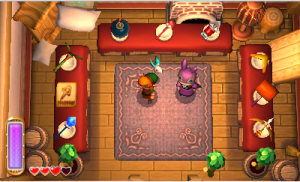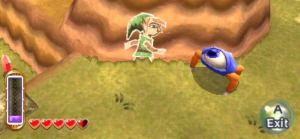The Legend of Zelda has become one of Nintendo’s flagship series and has grown and changed with the style of the times. While the series has gone through some transformations over the years, it has kept to a regular blueprint in terms of progression and design.
Legend of Zelda: A Link Between Worlds features a return to classic Zelda gameplay, with some interesting changes. And I’m not sure if we call this a modern game with a classic twist, or a classic game with a modern re-imagining.
Past and Present:
A Link Between Worlds is one of the few times in the Zelda series, where we’ve gotten a sequel to one of the games. Normally each Zelda game takes place in a different version of Hyrule with different versions of Link and Zelda.
Between Worlds takes place in the same Hyrule as A Link to the Past, which is considered one of the best 16 bit era games ever made by most. The game map of Between Worlds is an exact copy of A Link to the Past: Same dungeon locations, villages and even secret spots.
However Between Worlds does have new secrets, minigames and expanded areas to explore. The story however isn’t so much a sequel but just another version of the Zelda mythos. A strange man is going around capturing people inside of paintings and of course it turns out that Link is the chosen one needed to save the land.
Between Worlds features some new mechanics that change up the Zelda formula. First is that the majority of Link’s items are now bought from a store as opposed to being dungeon unlocks.
A strange man moves into Link’s home and offers him to rent or buy items for rupees. Rented items remain with the player unless Link runs out of hearts and then will be required to rent them again. Buying an item requires a lot more rupees but the item will remain permanently with the player.
This change up does effect the pacing of the game as skilled players should be able to get enough money to buy everything relatively fast.
On the other hand, people who keep dying will have to do some backtracking to the shop. Fortunately, fast travel becomes unlocked within about the first hour of playing and waypoints cover all the major areas.
Dungeon design has been altered and while Link will be visiting the same places as in A Link to the Past, all their layouts and puzzles have been redone. While you will be making use of one item in each dungeon, the general theme of the dungeon is used more in the puzzles than before.
I liked the dungeon designs in Between Worlds and the variety does keep things fresh. The change in item progression also means that the game world is less linear compared to previous Zelda games. Normally the player has to go through each dungeon in the same order to unlock the items and progression needed to move forward.
But with Between Worlds, you can do the dungeons in any order as long as you have the specific item from the shop (with exception to the latter half of the game.)
Another new mechanic is the ability for Link to transform into a painting and move along the walls, as long as he has enough energy. Energy is also used whenever the player wants to use an item and regenerates pretty quickly. Wall moving is an interesting trick and opens up the exploration and puzzle solving dramatically.
Speaking of exploration, Between Worlds is the least “hand holding” Zelda game I’ve seen since the original Zeldas. Outside of a few basic tutorials, the game cuts you loose. This is interesting as there are no prompts or cut scenes explaining mechanics this time, the developers leave it up to you to figure out how things work.
If you do get stuck, you can spend 3DS playcoins to unlock a hint for the specific puzzle. When it comes to the decision, I’m somewhat between two minds about it (no pun intended.)
On one hand, lesser skilled or younger gamers may find things a bit frustrating having to figure out everything themselves and the punishment for dying. While as a veteran of the series, I love the fact that you are effectively “cut loose” and able to do what you want within Hyrule.
When you add in the redesigned dark world along with how wall moving is tied in, gives you plenty of secrets to find.
Between Worlds is an interesting game from Nintendo. The changes to the formula are not as in your face as they were in Ocarina of Time or Windwaker and are more under the surface.
Between Worlds shows a level of restraint from Nintendo. It would have been easy to add more touch based functionality, an annoying guide, use of the microphone or 3D for puzzle solving.
Instead, you can play the entire game without the use of the touch screen and just the regular buttons , showing a level of refinement of Nintendo’s game design. It’s also proof that Nintendo can lean towards appealing to higher skilled gamers without completely closing out the mainstream fans.
If I had to criticize any part of the game, the only things that slightly bothered me were that I couldn’t find a way to put away an item after targeting with it without losing energy. And I noticed some slowdown when wall moving. The actual main quest is also on the short side, but that is largely due to how quick you can get to the various dungeons.
On my first play, I skipped a lot of the side quests and collectibles and going back through on the unlocked hard mode, I missed quite a lot.
Other than that, this is more Zelda goodness from Nintendo and the only explanation of someone hating this game, is if they are completely burned out on the franchise as a whole.
I really hope that this the start of an overall refinement of Nintendo’s design philosophy and not exactly aiming completely towards older audiences, but taking them more into the consideration when coming up with game design.
Legend of Zelda: A Link Between Worlds is a great mix between classic Zelda gameplay with modern refinements and continues Nintendo’s track record of quality Zelda games.





Pingback: The 2013 Game-Wisdom Awards #2 | Game Wisdom()